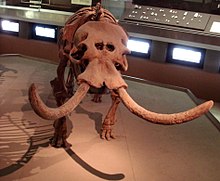Palaeoloxodon falconeri
Appearance
| Elephas falconeri Temporal range: Late Pleistocene
| |
|---|---|

| |
| Scientific classification | |
| Kingdom: | |
| Phylum: | |
| Class: | |
| Order: | |
| Family: | |
| Genus: | |
| Species: | E. falconeri
|
| Binomial name | |
| Elephas falconeri Busk, 1867
| |
Elephas falconeri is an extinct Siculo-Maltese species of elephant closely related to the modern Asian elephant. In 1867 George Busk had proposed the species Elephas falconeri for many of the smallest molars selected from the material originally ascribed by Hugh Falconer to Elephas melitensis.[1][2] This island-bound elephant was an example of insular dwarfism, reaching only 90 cm (3 ft) in height. E. falconeri's ancestors most likely reached the Mediterranean islands it was found on because of the low sea level during the Messinian salinity crisis.


See also
References
- ^ Busk, G. 1867. Description of the remains of three extinct species of elephant, collected by Capt. Spratt, C.B.R.N., in the ossiferous cavern of Zebug, in the island of Malta. Trans. Zool. Soc. London, 6: 227-306.
- ^ Palombo, M.R. 2001. Endemic elephants of the Mediterranean Islands: knowledge, problems and perspectives. The World of Elephants, Proceedings of the 1st International Congress (October 16-20 2001, Rome): 486-491. PDF fulltext
